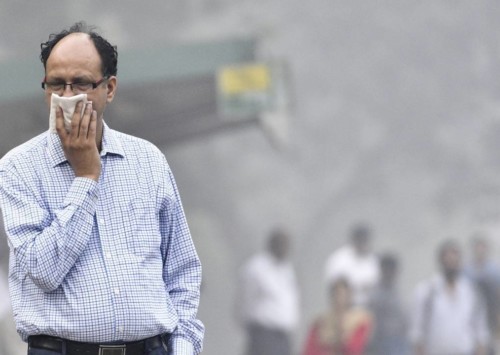Air pollution in South Asia

India had registered around 890,000 deaths linked to air pollution in 2010, translating into a 50 pc jump in deaths.
In various global studies, South Asia, home to nearly two billion people, continues to top air pollution-related deaths, with little signs of improvement.
A quick look at the global map of air pollution in the Global Disease Burden (GDB) report of 2018 shows a dark maroon belt of tropical countries, stretching from South Asia to west Africa. These are the countries with the worst air pollution in the world, while many of the nations are relatively sparsely populated, but at the eastern fringe of the belt, South Asia, is home to nearly two billion people, nearly 30 pc of the world’s population.
In the report, released in mid-2018, South Asia accounted for also more than half global premature deaths recorded the previous year due to air pollution. Worryingly for India and its neighbours, while China and India registered nearly half the global air-pollution related deaths, both over 1.3 million each, China has shown a dramatic improvement in curbing the number of deaths, while the deaths in India and South Asia continue to rise sharply. India had registered around 890,000 deaths linked to air pollution in 2010, translating into a 50 pc jump in deaths. Some other estimates put the numbers at over 1.6 million.
The year 2019 is hardly turning to be any better for residents in South Asia. Indian capital, New Delhi, has been reeling under severe air pollution since Diwali, the Indian festival of lights, during which uncontrolled fireworks saw air pollution levels shoot beyond the scale, clocking over 1,000 parts per million of micro particles, while the safe limits are 50 ppm. Since then, the pollution levels in New Delhi have remained severe or close to severe. The situation in other key cities of South Asia, including Kathmandu, Dhaka and Karachi, though not as severe as New Delhi, has been worsening also. Indeed, the GDB report pointed out that Pakistan, Bangladesh and India had recorded the steepest rise in air pollution-related deaths since 2010.
Clueless government
Despite clear evidence of the rising problem and the seriousness of the issue, governments in South Asia seem to be helpless and clueless on resolving it. The four biggest causes of air pollution are uncontrolled construction and industrial emissions, automotive pollution as well as agricultural practices such as burning fields to clear them after harvest.
It is not that the governments or the societies need to be told where the solutions lie. Many of the measures to curb air pollution are self-evident. But, across the region, the governments have shown a total lack of political will necessary to impose measures to check this menace. Last year, India, for instance, made it an offence, punishable with hefty penalties, for farmers to burn their fields. However, come the winter of 2018, the entire north India was covered by dense clouds of smoke from fields as practically all the farmers went ahead and burnt, instead of using other techniques such as machines to clear the field.
While for the larger farmers, it may have been a matter of choice, but for most farmers, specially the ones with meagre landholdings, it was a question of money. India has been going through a severe farm crisis, with thousands of heavily indebted farmers committing suicide and thousands other destroying their crops in protest against ridiculously low prices, often adding up to less than a few dollars for an entire harvest. The number of suicides is believed to have gone up by almost 50 pc in 2018 as farmers battled drought, higher input costs and record low prices for their crops.
An onion farmer in Maharashtra sent to Prime Minister Narendra Modi the measly USD 15 that he had gotten for selling 750 kg onions. Another farmer in Agra also sent to the PM USD 7 that he had been paid for his crop of 19 tonnes of potatoes. In this situation, for the government to expect the farmers to shell out additional costs is not only unrealistic but almost criminal as well. The fate of farmers in Nepal, Pakistan or Bangladesh is hardly any better as nature’s vagaries, as well as ingrained poverty and lack of adequate government support for farmers to even eke out a living, is a common feature of South Asia.
Poor monitoring
With relatively high growth in the economy, the region has also seen a sharp rise in construction and automotive industry. India has seen a six-fold rise in cars and two-wheelers on the roads in the last two decades, most of them emitting noxious fumes as they race around the crowded roads. Dhaka, the capital city of Bangladesh, has seen car sales triple over the last five years. Similarly, the region has seen unprecedented construction for offices, homes, shopping centres and industry as a growing middle class starts to spend some of the higher disposable income in these countries.
Once again, poor monitoring or even a total absence of monitoring of these industries has led to rise in air pollution. A study by IIT, Kanpur, a reputed technology institute, found that dust, including from construction, accounted for half the air pollution, while industry added nearly a quarter more, with automobiles and farms contributing most of the rest. But it is rare to see a construction site or a factory being shut down or penalised for not following the norms.
While the governments seem to be wringing their hands, the people are far too busy trying to earn a living, find a good school for their children or get access to health, to worry about this almost invisible and silent killer. Though there are a few NGOs that raise the issue, the media, has been watching the deterioration from the sidelines rather than take cudgels on behalf of the people. With over half the world’s poorest population, many South Asians believe that their biggest problems relate to their survival today rather than death, even if premature, years later.












